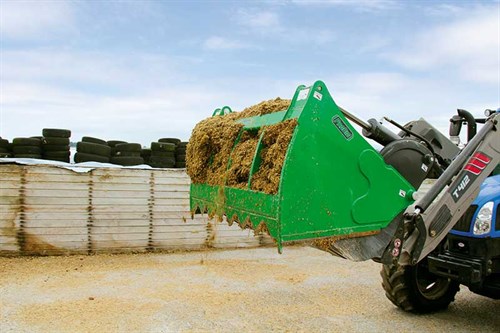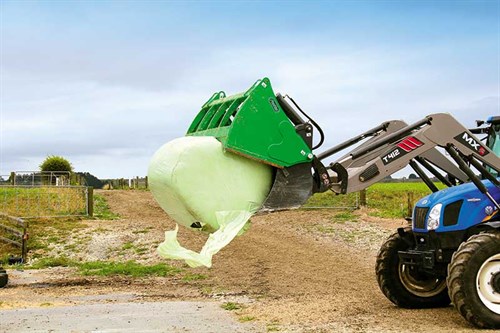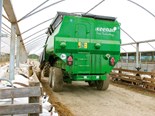ProDig Shear Genius review



















|

|

|

|

|

|

|

|

|
This month Jaiden tests the Shear Genius by ProDig, a product out of Ireland that caught the eye of Ben Peters, sales manager for Giltrap AgriZone (GAZ) that is now the sole New Zealand importer and distributor of these machines.
I am a big fan of implements that mean I don’t have to get out of the tractor, partly because I am lazy and there is a chance I will get my hands dirty, but mainly because it can save stacks of time particularly when carrying out repetitive tasks such as loading different feeds daily into a mixer or feedout wagon.
This leads me to this month’s test of ProDig’s Shear Genius. The name is a clever play on words as it is the perfect all-round tool for mixing and feeding a variety of products daily – you can do it all with this one machine. The Shear Genius is also ideal for loading silage or maize from a pit while opening far enough to split round bales in half. The bucket also allows loose material and liquids to be added. Although not cheap these machines are well under half the price of buying a bale shear, big bucket and a shear grab, which are the three machines this one makes redundant plus when you add the time savings and convenience on top – it really does start to stack up.
This machine doesn’t just suit those who have concrete bunkers and diet feeders, the Shear Genius is also a good fit for those with a silage wagon who just feed bales but may also dabble in a bit of Palm kernel. Furthermore, this machine can stay on the tractor as simply a bale slicer, which in itself is a great tool for keeping the wrap without having to hop out of the tractor, but its ability to do other tasks as well, means this is no one-trick pony.
Company background
As mentioned, GAZ are the importers here in New Zealand, however ProDig Attachments, based in County Carlow in the south-east of Ireland, has been around for more than 20 years after being set up by brothers Donny and Eamonn Nolan – both of whom are still heavily involved today. These machines look very well built with no lack of steel although 3D CAD allows strength to be delivered from the least amount of weight which will no doubt give years of service without ruining the loader and front axle of your tractor.
In the ProDig portfolio there is a wide range of products for the agriculture, construction and recycling sectors, from large buckets to bale clamps, silage grabs and large folding silage forks for silage stacks.

The test
Originally only available in 1.8- and 2.2-metre widths, the smaller 1.5-metre machine we tested has been developed for a market such as New Zealand where loading with tractors is more popular than telehandlers – having a bigger attachment would have simply been too heavy for 100hp tractors.
Daryll Horgan in Tikorangi (north Taranaki) kindly lent us his tractor and facilities so we could have a hoon with the 1.5-metre machine on his T6.160 New Holland. Horgan admits the slightly larger 1.8-metre attachment would have better suited his tractor as it has the ability to handle the small increase of 150kg tare weight, and the ability to do less trips to the mixer was the big appeal.
Horgan had scales in his tractor so we could accurately tell exactly how much product the machine was taking with each bite – 750kg of maize, 300kg of PKE and the bales weighed an average of 700kg.
Now we can work out the approximate carrying capacity of the other two machines in the range as the width is the only difference, whereas height and depth all stay constant.
- 1.5m: 1m3 capacity – 300kg of PKE, 750kg maize
- 1.8m: 1.3m3 capacity – 390kg PKE, 975kg of maize
- 2.2m: 1.6m3 capacity – 480kg PKE, 1200kg maize
Tare weight of the 1.5m is 600kg, the 1.8m is 750kg and the 2.2m is 850kg. The only real difference in design is the two larger buckets have two strengthening gussets in the bucket, and the sides of the top shear itself have cut outs, while the 1.5m has a solid side and no gussets in the bucket. All are designed to keep weight to a minimum while obtaining maximum strength.
Design and build
When it comes to the strength of the Shear Genius the key feature for me is the genuine Hardox bucket cutting edge and shear knives which not only add a large amount of strength but will last for years longer than simple mild steel. The hardened tempered serrated blades on the front of the grab are primarily used for a cleaner cut using less force with the desired outcome of leaving a perfect stack face preventing secondary fermentation.
To prevent the blades coming in contact with the concrete, the two teeth are not cutting edges and extend a lot lower. The top shear extends past the bottom edge of the bucket to over-bite the material and create a better cut right through the ram cycle. Speaking of rams, the grab is powered by two nickel chromed double-acting rams which ensures protection against rust and damage to the hydraulic seals. Only one hydraulic port is required for both the top grab and the hydraulic wrap fingers with a pressure relief valve for loaders with high pressure hydraulics.

The Bale Shear – how it works
Through sequencing, a single double-acting third service operates both the shear and plastic retaining device. This means that to ready the teeth, the top shear must be fully open. You then crowd the grab to 45 degrees over the top of the bale and push down hard to ensure the plastic is sitting against the grab fingers. Close the grab to grip the bale and then lift it up off the ground or over the wagon. First shut the grab enough until half of the bale has fallen into the wagon, then back up and dangle the draping wrap on the outside of the wagon so when the remainder of the bale drops it doesn’t take some plastic with it. Then open the shear until you can see about an inch of the ram spears and then the rest of the bale will drop. Lift it back up and then fully open the shear to retract the grabbers and the plastic will fall where you intend to leave it – piece of cake!
A trick for young players here is to fully open the top to let the second half of the bale drop into the wagon. By doing so this will also drop the plastic as you have opened the grabbers, this is why it is important to leave an inch or so showing on the ram spear to avoid this.
The verdict
This is a great machine as from one capital purchase you get something with so many uses – it really is a perfect fit for Kiwi farmers. The price and weight of the Shear Genius might scare a few but when you take away any secondary fermentation from the stack face in both maize and silage and the accelerated feed value loses associated with this, plus the fact that it’s not much more expensive than a bale shear, which really is a one-trick pony – then this machine is good value for money.
Three-machines-in-one plus the ability to be constantly feeding high-quality forage all without leaving your tractor seat makes a compelling argument, even when profit margins are under high pressure thanks to the current dairy payout – it’s a no brainer.
Read the full test in the latest issue of Farm Trader magazine. Subscribe here.
Keep up to date in the industry by signing up to Farm Trader's free newsletter or liking us on Facebook


.jpg)
.jpg)
.jpg)
.jpg)
.jpg)
.jpg)
.jpg)
.jpg)
.jpg)




